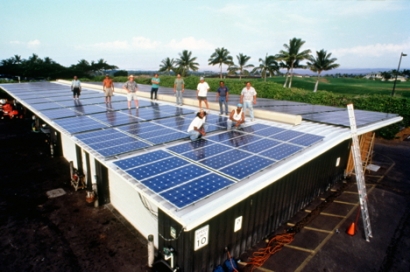
Counties require new training for firefighters that support advancements in residential renewable energy sourcing. They learn about cross-ventilation, inhalation health hazards, electrocution and electrical burns, and solar battery hazards. With adequate instruction, firefighters can protect communities and the environment.
The weight of solar panels introduces adverse effects to ignited homes. Each panel is roughly 40 pounds, extending 3 feet wide and 5 feet long. Roofs generally contain multiple panels, increasing the total weight on the structure. They can weaken a vulnerable roof, limiting firefighters’ access to the fire source from above.
Firefighters use vertical ventilation to diffuse toxic gas and smoke on panel-less homes. They remove the roof section above the fire source, allowing smoke to travel naturally up and out of the house. But solar panels prevent professionals from safely eliminating portions of the roof, preventing vertical ventilation.
Cross-ventilation offers an effective solution to smoke diffusion in solar homes. Many individuals use this method of aeration to cool their homes in the summer or release smoke when cooking. Firefighters will cut sections of the house on the windward and leeward side, naturally forcing air through the structure.
Before cutting into a solar home, professionals should evaluate its features that may interfere with their extinguishing process. Houses composed of hardwood are more stable, providing greater security for firefighters. Hardwood produces more heat than softwood, and softwood generates more extensive amounts of smoke. Firefighters should consider these features when creating a plan of action on-site.
As heat degrades solar panels during a house fire, they generate toxic air pollution. The devices contain cadmium telluride, lead, cadmium gallium selenide, silicon tetrachloride, hexafluoroethane, and more. When a fire melts these elements, they create health-hazardous smoke.
Firefighters can protect themselves from localized air pollution by wearing a self-contained breathing apparatus. They can preserve the surrounding community’s health by evacuating individuals living downwind from the fire.
When entering a flame-encompassed home, professionals should beware of live wires suspended from solar panels. If touched, these wires could send high-voltage electricity to the heart, causing injury or death. Many individuals recommend turning off the primary electricity source before entering a burning building.
In small, concentrated fires, professionals could switch off the solar panel’s inverter on the meter box. Then they can turn off the breaker, eliminating electricity flow through the home. When larger fires occur, professionals should not turn off the electricity source.
If a home is engulfed in flames, approaching the meter box may be dangerous. Touching this system could cause electrical burns. When an electric current enters the body, it converts electricity into heat. This results in a thermal burning of internal organs and tissues. Firefighters should evaluate the severity of the fire before interacting with the meter box to protect themselves.
Firefighters must also address the battery storing renewable energy on the scene. If residents mismanage their solar system, electrical abuse may occur. An electrically abused battery becomes overworked and emits flammable gases into the environment.
When fires occur in homes with gas-emitting batteries, they may explode. Firefighters can prevent explosions by extinguishing the solar battery with foam, a dry-chemical extinguisher, or carbon dioxide.
Professionals should also avoid cutting into the electricity storage system when entering an ignited home. A punctured battery may expose internal chemicals to the fire, increasing the risk of explosions.
Renewable energy will fuel the world in the coming decades. As we phase into this eco-conscious era, we should place safety first. Firefighters must pursue solar panel education to ensure their safety when extinguishing homes and protecting surrounding citizens.

